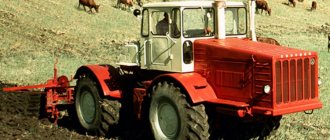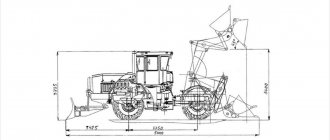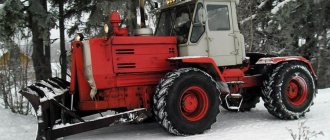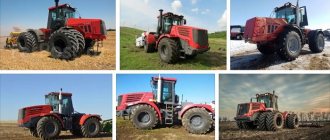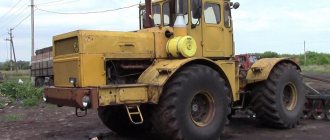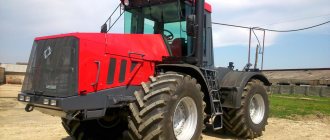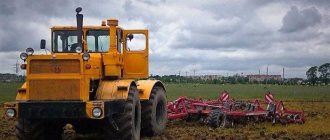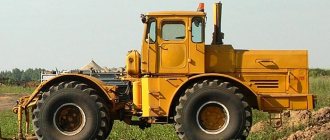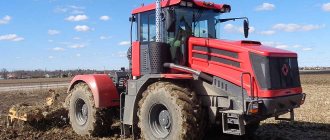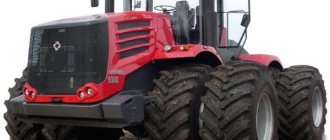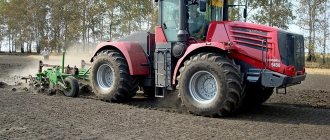In the early 1960s, the Soviet government set a task for agricultural workers: to bring the average annual grain harvest to 238-243 million tons. This was impossible without powerful tractors, and they immediately began to be produced. The Kirovets K-700 made a kind of revolution in large-scale farming, giving a powerful impetus to the development of this industry.
By the early 1990s, this powerful machine covered up to 40% of basic agricultural work. The K-700 was especially in demand in the grain-growing regions of Russia, Ukraine, and Kazakhstan. “Kirovets” also became famous for being the first Soviet tractor with rubber tires. Both our own experience and world practice said that such a tractor would be more convenient than a caterpillar tractor or one with metal wheels to move along highways at high speed under its own power, and would be easier to fit into the growing cargo flow.
Working in winter and summer, insensitive to Russian off-road conditions and quite comfortable, the Kirovets served for 20-30 years continuously on Soviet fields.
In the fall of 1959, N. S. Khrushchev, who was on a visit to the USA, was shown a powerful MV wheeled tractor from John Deere. The Head of the CPSU and the Soviet government not only appreciated it, but immediately upon his return, set the task of organizing production in the USSR on principle new energy-rich high-speed general purpose tractors with a capacity of 200-220 hp. with a wide train of mounted and trailed implements. Indeed, such cars were not produced in our country at that time, but they were needed.
History of the K-700
The Leningrad Kirov Plant was tasked with developing a new tractor in the shortest possible time and putting it into production. The company had extensive experience in tractor manufacturing: since 1924 it has produced the Fordson-Putilovets, and since 1934 the Universal. From 1924 to 1936, Kirov residents produced about 40 thousand machines that replaced the horse and plow. Conversion to heavy tanks during the Great Patriotic War contributed to the creation of a solid design and production-technological base, which was also quite suitable for tractors. A comprehensive reconstruction of the enterprise began. Many old buildings were demolished, and in their place huge buildings equipped with the latest equipment were erected. A 250 m long conveyor appeared in the tractor assembly building. A large forging and stamping shop, a welding shop, a tractor delivery shop, etc. were built.
At the end of 1961, the Kirov Plant began creating the most powerful tractor at that time - the K-700. In January 1962, a technical design was developed and approved, and in May working drawings of experimental K-700 tractors were prepared. The design of this machine and the production of its pilot batch were completed in an unprecedentedly short time. This became possible thanks to the highly qualified personnel of designers, engineers and workers, for which the plant has always been famous, since the time when it was called Putilovsky. Soon the enterprise began mass production of the powerful Kirovets K-700 wheeled tractors created by the team.
Launch into series
The first copies were created in 1962 and immediately showed their best performance. The construction of the conveyor began almost immediately and the first cars came out of it already in 1964. The conveyor reached full capacity by 1969, when it was able to produce 20 thousand tractors per year. For example, nowadays only 3000-3500 pieces are produced at several sites. At that time, this was simply a gigantic volume, because in the West such models were just beginning to be produced, and in the USSR by 1975, 100 thousand of such machines had already been created.
Read Airplane An-22 "Antey"
Testing a new tractor
Straight from the assembly line, the first Kirovets went to the fields of a suburban state farm for pre-factory debugging tests in the field. A huge, powerful machine, dragging an eight-furrow plow, laid the first furrow 25-27 cm deep. The tractor moved at an unprecedented speed, turning over huge layers of earth. Soon the first one was joined by two more Kirovets. A practical test confirmed the main technical indicators included in the project. In March 1963, seven more vehicles were sent for state testing.
Now the conditions have become more difficult: in Kazakhstan, during cotton sowing, in Azerbaijan, on difficult-to-cultivate soil, in Rostov-on-Don. In 1963, 50 K-700 tractors were manufactured. Soon the plant began mass production of Kirovets. By the end of 1964, there were already 1,200 vehicles in service. In 1966, production increased to 3820 tractors and increased from year to year. In 1975, the 100,000th Kirovets rolled off the assembly line of the Kirov plant. Each subsequent five-year period was marked by another hundred-thousandth anniversary: 1980 - the 200,000th tractor, 1985 - the 300,000th tractor. In 1987, a record was reached - 23,003 tractors. There were no analogues in world practice.
These machines helped not only raise large-scale agriculture to a higher level, but were also effectively used in the mining and gold mining industries, in land reclamation and irrigation work, and in large new buildings.
A new stage in tractor manufacturing
The K-700 is a tractor that many confidently consider to be progress in the history of agricultural machinery production. With the help of this powerful hero, workers in the agricultural sector were able to triple the efficiency and productivity of agricultural work.
After all, what kind of equipment was used in the fields in the 50s of the last century? These were tracked, not very powerful DT-54s. They were used before the war and by some miracle remained on the field. Time itself dictated the need for new technologies. K-700 is a tractor that began to lift virgin soil. With it, the agricultural lands of Kazakhstan, Kuban and many others were developed. The car had all the necessary characteristics. For effective processing, high speed, energy density and productivity were needed.
25 years ahead
In 1968, the K-700 tractor received a gold medal at an exhibition of agricultural machines in Germany, and in 1969 it was recognized as the world's most powerful agricultural wheeled tractor at the 40th Paris Salon-Exhibition of Tractors and Agricultural Machines. Indeed, the power, labor productivity, reliability, ease of operation and repair of the Kirovets met the world requirements of that time. Moreover, experts claim that this machine is at least 25-30 years ahead of its European counterparts.
The tractor frame consists of front and rear articulated semi-frames. The front frame is equipped with a water-cooled engine, an oil system (engine oil cooler and gearbox), air filters and an engine pre-heating system, as well as a pedestal, cabin, fuel tank and cladding parts. The front axle is attached to the bottom. A linkage mechanism with lifting hydraulic cylinders, a coupling and a single-speed power take-off shaft gearbox are installed on the rear semi-frame of the tractor. The rear axle is attached to the rear semi-frame from below using stepladders.
The K-700 tractor is equipped with a four-stroke eight-cylinder diesel engine YaMZ-238NB with a power of 220 hp. with a turbocharger and a two-stage air purification system. The engine cylinders are cast together with the upper part of the crankcase and are arranged in two rows in the form of a Latin letter V with a camber angle of 90°. This arrangement is due to the desire to reduce the length of the engine, which contributes to a more rational layout and a reduction in its overall weight. The reciprocating motion of the pistons is transmitted to the crankshaft mounted in a block on five supports. Each cylinder has a gas distribution system with two valves: intake and exhaust. Air is supplied to the cylinders by a turbocharger under excess pressure. As a result of turbocharging, an increased dose of fuel is burned, and, consequently, engine power increases. The thick-walled piston crown houses an open toroidal combustion chamber that provides maximum air swirl.
The K-700 tractor does not have a clutch. Instead there is a drain pedal (pressure drop in the gearbox hydraulic system). The gearbox is mechanical, with constant mesh gears, hydraulically controlled four clutches and mechanically controlled gear clutches. All gears are straight-cut. Number of gears (hydraulic) - 4 (plus 2 neutral), 4 modes (mechanical), high-low switching. As a result, the number of speeds is 16 and, accordingly, 8 rear. The box is designed to change gears without loss of power (due to friction clutches). Modes are switched by moving gears, as in any manual transmission. The speeds change when the spool is switched (by redirecting the hydraulic oil flow), the 2nd neutral turns off the hydraulic flow, the 1st neutral, in addition to turning off the hydraulic flow, mechanically brakes the drive shaft (shaft with clutches) in the gearbox, like a hand brake.
Thus, a gearbox with 16 speeds in 4 ranges, 2 drive axles, a mechanical transmission, and hydraulic control of switching within modes ensured the efficiency of technological, working and transport modes. The hydraulic turning system and articulated frame optimized the layout and increased the maneuverability and maneuverability of the tractor. New traction qualities (5 tons on a hook) and a speed of up to 10 km/h when plowing increased labor productivity in agricultural and transport operations by 2-3 times and reduced the agrotechnical time required for agricultural work by 2 times.
Specifications
The engine power was 220 horsepower. The diesel fuel tank had a volume of 450 liters. When moving forward, the car reached a maximum speed of 33.8 kilometers per hour. If reverse gear was engaged, then the maximum speed was 24.3 kilometers per hour. The tractor clearance was 440 millimeters.
Repair of the K-700 tractor mainly comes down to regular maintenance according to regulations, as well as replacement of consumables. If you properly care for the main components, there will simply be no serious breakdowns. Mostly there are problems with the gearbox of these cars. But with proper and timely care there will be no problems with such a tractor. There is also a lot of literature devoted to the maintenance and repair of Kirov vehicles.
Working conditions of the K-700 tractor driver
The designers paid special attention to the working conditions of the tractor driver. The tractor cabin was made all-metal, sealed, equipped with a ventilation and heating system and sprung seats. In addition, there was a first aid kit, rear-view mirrors, windshield wipers, sun visors, interior lighting, turn signal lights, side lights and brake lights. A box for a tank with drinking water was welded to the rear wall of the cabin, and a panel with control instruments, toggle switches and signal lamps was installed on the front wall. All basic operations for assembling a tractor with various implements could be performed by the tractor driver himself.
Models created on the basis of the K-700 tractor
In 1975, the Kirov Plant began serial production of the K-700A tractors with an 8-cylinder YaMZ-238NDZ engine (235 hp) and K-701 with a 12-cylinder YaMZ-240BM2 engine (300 hp). The only difference between these models was the engine, but both were very different from the base K-700. So, they had different wheels (not unified with the wheels of the K-700 tractor), not one, but two fuel tanks (side), which merged into a single unit with the front wings of the tractor, there were no springs. This option began to be used in other sectors of the national economy of the USSR. For installation on the rear semi-frame of the K-700A and K-701 tractors, various equipment was developed: loading P-4, P-4/85, stacking, etc.
On the basis of the next model, K-703, with a reversible control post, the LT-163 timber stacker (after the LT-195 modernization), the ML-56 timber skidding machine, the LB-30 gradedozer, the PF-1 front-end loader, and the DM- universal road machine were created. 15, etc. To perform reclamation and other work, a trencher was developed on the basis of the Kirovets tractor.
Seeing the great demand for the Kirovets in other sectors of the national economy, the Kirov Plant produced a wide variety of equipment based on this tractor model: tractors, bulldozers, loaders, vibratory rollers, snow blowers, mobile welding units, etc. Demand for K-700 series machines and its modernization does not decrease to this day.
Subscribe to our Telegram channel
Design Features
In the early 90s, Kirovets were used for 40% of agricultural work. These heroes worked throughout the year and were given virtually no rest. The machines performed well not only in sowing or harvesting work, but also as the main vehicle for the agricultural industry of the USSR. K-700 are reliable, efficient field workers, ideal for use in difficult conditions.
Now let’s look at the characteristics of the K-700 tractor. The geometric characteristics are as follows: 7235 mm in length, 2530 mm in width, 3225 mm in height. This tractor weighed, as we said earlier, eleven tons.
